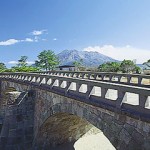**************** Contents ****************
The Dates for 2022 And The Meanings of 24 Sekki And The Zassetsu
What IS 24 Sekki?
A year is divided into four seasons But here in Japan, there is also a calendar to divide a year into 24 sections.
It is called “24 Sekki (24節気).
In days long gone, people needed to know when to sew fields, when to harvest and other things related to living with nature and the changing seasons.

24 Sekki (the twenty-four divisions of a year) is originally from China.
In old China, people also had troubles with the gap between their calendars and the actual seasons.
People needed to accurately know the seasons’ transitions,
and that’s why the 24 sekki was invented.
It came to Japan in the 6th century.
However, some of the Chinese seasons don’t match Japanese seasons,
so zassetsu (雑節 / specific days for seasons other than the twenty-four divisions of a year) was added on Japanese calendars.
The Dates for 2023 /
The Meanings of 24 Sekki And The Zassetsu
24 SEKKI, 2023
|
Season |
Months based on 24 SEKKI |
No. |
SEKKI |
Meaning |
Date |
|
Spring |
January |
1 |
The start of spring |
Feb.4th |
|
|
2 |
The season the snow changes into rain and ice changes into water” |
Feb.19th |
|||
|
February |
3 |
The season when wintering insects come out of hibernation |
Mar.6th |
||
|
4 |
The vernal spring equinox |
Mar.21st |
|||
|
March |
5 |
Clear and bright season |
Apr.5th |
||
|
6 |
Grain rain season |
Apr.20th |
|||
|
Summer |
April
|
7 |
The beginning of Summer |
May 6th |
|
|
8 |
The season when the weather becomes fine and everything starts to go well. |
May 21st |
|||
|
May
|
9 |
Time of planting grains |
Jun.6th |
||
|
10 |
The summer solstice |
Jun.21st |
|||
|
June
|
11 |
The beginning of midsummer |
Jul.7th |
||
|
12 |
Midsummer (lit. big heat, blistering heat) |
Jul.23rd |
|||
|
Autumn |
July
|
13 |
The beginning of autumn |
Aug.8th |
|
|
14 |
The season in which heat stops |
Aug.23rd
|
|||
|
August |
15 |
The season of Glistening dew |
Sep.8th |
||
|
16 |
The autumnal equinox |
Sep.23rd |
|||
|
September |
17 |
The season of cold drops of dew |
Oct.8th |
||
|
18 |
The season with the first frost of the autumn |
Oct.24th
|
|||
|
Winter |
October
|
19 |
The beginning of Winter |
Nov.8th |
|
|
20 |
The season the snow starts falling a little |
Nov.22nd |
|||
|
November |
21 |
The season in which it snows not only in the mountains but on the plains, too |
Dec.7th
|
||
|
22 |
The winter solstice |
Dec.22nd |
|||
|
December |
23 |
The beginning of midwinter and the season of cold wind the snow |
Jan.6th |
||
|
24 |
The coldest season of the year (lit. big coldness) |
Jan.20th
|
Zassetsu, 2023
| Zassetsu | Meaning |
Date |
| FUYU-DOYŌ 冬土用 |
18 days period before Risshun (立春 / The beginningof Spring) *Doyo is a change of season. |
Jan.17th~Feb.3rd |
| SETSUBUN 節分 |
The traditional end of winter. (Bean Throwing Night) |
Feb.3rd |
| HARU-HIGAN 彼岸 |
The vernal equinoctial week (Buddhist ritual at the vernal equinox) |
Mar.18th~ Mar.24th |
| SHANICHI (Spring) 社日 |
“Tsuchinoe“ day that falls closest to the vernal equinox (The day to worship land god) |
Mar.21st |
| HARU-DOYŌ 春土用 |
18 days period before Rikka (立夏 / The beginning of Summer) *Doyo is a change of season. |
Apr.17th~ May 5th |
| HACHIJŪ-HACHIYA 八十八夜 |
The 88th day from the day of Risshun (People used to consider planting rice on this day.) |
May 2nd |
| NYŪBAI 入梅 |
The start of the rainy season | June.11th |
| HANGESHŌ 半夏生 |
The 11th day from the summer solstice and the end of the rainy season | Jul.2nd |
| NATSU-DOYŌ 夏土用 |
18 days period before Risshu(立秋 / The beginning of autumn) *Doyo is a change of season. |
Jul.20th~ Aug.7th |
| NIHYAKU-TŌKA 二百十日 |
The 210th day from the first day of spring according to the lunar calendar. (People have said that typhoons tend to come around this day.) |
Sep. 1st |
| NIHYAKU-HATSUKA 二百二十日 |
The 220th day from the first day of spring according to the lunar calendar. (People have said that typhoons tend to come around this day, too.) |
Sep.11th |
| Aki-HIGAN 秋彼岸 |
The Autumn equinoctial week. (Buddhist ritual at the autumnal equinox) |
Sep.20th~ Sep.26th |
| SHANICHI (Autumn) 社日 |
“Tsuchinoe“ day that falls closest to the autumnal equinox The day to worship land god |
Sep.27th |
| AKI-DOYŌ 秋土用 |
18 days period before Rittou(立冬 / The beginning of Winter) *Doyo is a change of season. |
Oct.21st~ Nov.7th |
Category : 24 Divisions of The Solar Year , Japanese Culture , text @en
Tag : 24 divisions of the solar year , 24sekki , corona virus , COVID-19 , COVID19 , Emergency , Japanese culture , season , tanabata , The coronavirus , 日本の文化




























